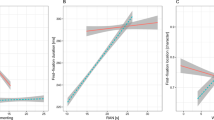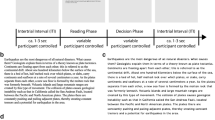Abstract
Although naming speed (NS) has been shown to predict reading into adulthood and differentiate between adult dyslexics and controls, the question remains why NS is related to reading. To address this question, eye movement methodology was combined with three letter NS tasks (the original letter NS task by Denckla & Rudel, Cortex 10:186–202, 1974, and two more developed by Compton, The Journal of Special Education 37:81–94, 2003, with increased phonological or visual similarity of the letters). Twenty undergraduate students with reading difficulties (RD) and 27 without (NRD) were tested on letter NS tasks (eye movements were recorded during the NS tasks), phonological processing, and reading fluency. The results indicated first that the RD group was slower than the NRD group on all NS tasks with no differences between the NS tasks. In addition, the NRD group had shorter fixation durations, longer saccades, and fewer saccades and fixations than the RD group. Fixation duration and fixation count were significant predictors of reading fluency even after controlling for phonological processing measures. Taken together, these findings suggest that the NS–reading relationship is due to two factors: less able readers require more time to acquire stimulus information during fixation and they make more saccades.
Similar content being viewed by others
References
Arnell, K. M., Joanisse, M. F., Klein, R. M., Busseri, M. A., & Tannock, R. (2009). Decomposing the relation between rapid automatized naming (RAN) and reading ability. Canadian Journal of Experimental Psychology, 63, 173–184.
Badian, N. A. (2001). Phonological and orthographic processing: their roles in reading prediction. Annals of Dyslexia, 51, 179–202.
Bowers, P. G., & Swanson, L. B. (1991). Naming speed deficits in reading disability: multiple measures of a singular process. Journal of Experimental Child Psychology, 51, 195–219.
Bowers, P. G., & Wolf, M. (1993). Theoretical links between naming speed, precise timing mechanisms and orthographic skill in dyslexia. Reading and Writing: An Interdisciplinary Journal, 5, 69–85.
Bowey, J. A., McGuigan, M., & Ruschena, A. (2005). On the association between serial naming speed for letters and digits and word reading skill: towards a developmental account. Journal of Research in Reading, 28, 400–422.
Bradley, L., & Bryant, P. E. (1983). Categorizing sounds and learning to read: a causal connection. Nature, 301, 419–421.
Compton, D. L. (2003). The influence of item composition on RAN letter performance in first grade children. The Journal of Special Education, 37, 81–94.
de Jong, P. F. (2011). What discrete and serial rapid automatized naming (RAN) can reveal about reading. Scientific Studies of Reading, 15, 314–337.
de Jong, P. F., & van der Leij, A. (1999). Specific contributions of phonological abilities to early reading acquisition: results from a Dutch latent variable longitudinal study. Journal of Educational Psychology, 91, 450–476.
Deacon, S. H., Cook, K., & Parrila, R. (2012). Identifying high-functioning dyslexics: is self-report of early reading problems enough? Annals of Dyslexia, 62, 120–134.
Denckla, M. B., & Rudel, R. G. (1974). ‘Rapid automatized naming’ of pictured objects, colors, letters, and numbers by normal children. Cortex, 10, 186–202.
Felton, R. H., Naylor, C. E., & Wood, F. B. (1990). Neuropsychological profile of adult dyslexics. Brain and Language, 39, 485–497.
Georgiou, G. K., Parrila, R., Cui, Y., & Papadopoulos, T. C. (2013). Why is rapid automatized naming related to reading? Journal of Experimental Child Psychology, 115, 218–225.
Georgiou, G., Parrila, R., Kirby, J. R., & Stephenson, K. (2008). Rapid naming components and their relationship with phonological awareness, orthographic knowledge, speed of processing, and different reading outcomes. Scientific Studies of Reading, 12, 325–350.
Georgiou, G., Parrila, R., & Liao, C.-H. (2008). Rapid naming speed and reading across languages that vary in orthographic consistency. Reading and Writing: An Interdisciplinary Journal, 21, 885–903.
Holmes, V. M. (2009). Bottom-up processing and reading comprehension in experienced adult readers. Journal of Research in Reading, 32, 309–326.
Hung, R. (2012). Orthographic learning in adults with reading difficulties. Unpublished Master’s thesis, University of Alberta, Edmonton, Canada.
Jones, M. W., Ashby, J., & Branigan, H. P. (2013). Dyslexia and fluency: parafoveal and foveal influences on rapid automatized naming. Journal of Experimental Psychology: Human Perception and Performance, 39, 554–567.
Jones, M. W., Branigan, H. P., Hatzidaki, A., & Obregon, M. (2010). Is the ‘naming’ deficit in dyslexia a misnomer? Cognition, 116, 56–70.
Jones, M. W., Obregon, M., Kelly, M. L., & Branigan, H. P. (2008). Elucidating the component processes involved in dyslexic and non-dyslexic reading fluency: an eye-tracking study. Cognition, 109, 389–407.
Kirby, J. R., Georgiou, G., Martinussen, R., & Parrila, R. (2010). Naming speed and reading: from prediction to instruction. Reading Research Quarterly, 45, 341–362.
Kirby, J. R., Parrila, R., & Pfeiffer, S. (2003). Naming speed and phonological awareness as predictors of reading development. Journal of Educational Psychology, 95, 453–464.
Kuperman, V., Van Dyke, J., & Henry, R. (2012, July). The visuo-oculomotor component of RAN is a strong predictor of eye-movements in reading. Paper presented at the annual conference of the Society for the Scientific Studies of Reading in Montreal, Canada.
Lefly, D. L., & Pennington, B. F. (2000). Reliability and validity of the Adult Reading History Questionnaire. Journal of Learning Disabilities, 33, 286–296.
Lepola, J., Poskiparta, E., Laakkonen, E., & Niemi, P. (2005). Development of and relationship between phonological and motivational processes and naming speed in predicting word recognition in grade 1. Scientific Studies of Reading, 9, 367–399.
Lervåg, A., Bråten, I., & Hulme, C. (2009). The cognitive and linguistic foundations of early reading development: a Norwegian latent variable longitudinal study. Developmental Psychology, 45, 764–781.
Manis, F., Doi, L. M., & Badha, B. (2000). Naming speed, phonological awareness, and orthographic knowledge in second graders. Journal of Learning Disabilities, 33, 325–333.
Parilla, R., Georgiou, G., & Corkett, J. (2007). University students with a significant history of reading difficulties: what is and is not compensated? Exceptionality Education Canada, 17, 195–220.
Parilla, R. K., Kirby, J. R., & McQuarrie, L. (2004). Articulation rate, naming speed, verbal short-term memory, and phonological awareness: longitudinal predictors of early reading development? Scientific Studies of Reading, 8, 3–26.
Poulsen, M., Juul, H., & Elbro, C. (2014). Multiple mediation analysis of the relationship between rapid naming and reading. Journal of Research in Reading. doi:10.1111/j.1467-9817.2012.01547.x.
Protopapas, A., Altani, A., & Georgiou, G. K. (2013). RAN backward: a test of the visual scanning hypothesis. Scientific Studies of Reading, 17, 453–461.
Stanovich, K. E. (1992). Speculation on the causes and consequences of individual differences in early reading acquisition. In P. B. Gough, L. C. Ehri, & R. Treiman (Eds.), Reading acquisition (pp. 307–342). Hillsdale: Erlbaum.
Torgesen, J. K., Wagner, R. K., & Rashotte, C. A. (1994). Longitudinal studies of phonological processing and reading. Journal of Learning Disabilities, 27, 276–286.
Torgesen, J. K., Wagner, R. K., & Rashotte, C. (1999). Test of word reading efficiency. Austin: PRO-ED.
Torgesen, J. K., Wagner, R. K., Rashotte, C. A., Burgess, S., & Hecht, S. (1997). Contributions of phonological awareness and rapid automatic naming ability to the growth of word-reading skills in second to fifth-grade children. Scientific Studies of Reading, 1, 161–185.
Vellutino, F. R., Fletcher, J. M., Snowling, M. J., & Scanlon, D. M. (2004). Specific reading disability (dyslexia): what have we learned in the past four decades? Journal of Child Psychology and Psychiatry, 45, 2–40.
Wagner, R. K., & Torgesen, J. K. (1987). The nature of phonological processing and its causal role in the acquisition of reading skills. Psychological Bulletin, 101, 192–212.
Wagner, R. K., Torgesen, J. K., & Rashotte, C. A. (1999). Comprehensive test of phonological processing. Austin: PRO-ED.
Wechsler, D. (1999). Wechsler abbreviated scale of intelligence. San Antonio: Harcourt Assessment.
Wiederholt, J. L., & Bryant, B. R. (2001). Gray oral reading tests. Austin: PRO-ED.
Wile, T. L., & Borowsky, R. (2004). What does rapid automatized naming measure? A new RAN task compared to naming and lexical decision. Brain and Language, 90, 47–62.
Wolf, M., Bally, H., & Morris, R. (1986). Automaticity, retrieval processes, and reading: a longitudinal study in average and impaired readers. Child Development, 57, 988–1000.
Wolf, M., & Bowers, P. G. (1999). The double-deficit hypothesis for the developmental dyslexias. Journal of Educational Psychology, 91, 415–438.
Wolf, M., & Denckla, M. B. (2005). Rapid automatized naming and rapid alternating stimulus tests (RAN/RAS). Austin: PRO-ED.
Yan, M., Pan, J., Laubrock, J., Kliegl, R., & Shu, H. (2013). Parafoveal processing efficiency in rapid automatized naming: a comparison between Chinese normal and dyslexic children. Journal of Experimental Child Psychology, 115, 579–589.
Zoccolotti, P., de Luca, M., Lami, L., Pizzoli, C., Pontillo, M., & Spinelli, D. (2014). Multiple stimulus presentation yields larger deficits in children with developmental dyslexia: a study with reading and RAN tasks. Child Neuropsychology. doi:10.1080/09297049.2012.718325.
Author information
Authors and Affiliations
Corresponding author
Rights and permissions
About this article
Cite this article
Al Dahhan, N., Georgiou, G.K., Hung, R. et al. Eye movements of university students with and without reading difficulties during naming speed tasks. Ann. of Dyslexia 64, 137–150 (2014). https://doi.org/10.1007/s11881-013-0090-z
Received:
Accepted:
Published:
Issue Date:
DOI: https://doi.org/10.1007/s11881-013-0090-z




